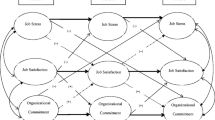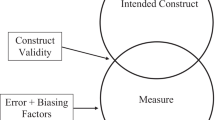Abstract
Previous monomethod research has found mixed support for nonlinear effects between certain job characteristics (e.g., job autonomy, job complexity) and outcome variables (e.g., job performance). We hypothesized that these weak nonlinear findings may be due to the prevalence of monomethod research that can lead to a lack of complete measurement and/or introduce common methods variance, either of which may mask the “true” shape of relationships. Using hierarchical regression analyses and a multitrait–multimethod (MTMM) research design, we found strikingly different results between monomethod and MTMM data when considering the relationships between three psychological climate variables and job satisfaction. While the monomethod results mirrored earlier inconclusive findings, the MTMM data indicated that nonlinear equations explained significantly more of the relationship between all three climate dimensions and job satisfaction. These results suggest that the use of MTMM data allows one to more effectively test for nonlinear effects. Furthermore, these nonlinear results suggest that the format of employee questionnaires should probably change from asking how much an employee has of certain constructs to asking does the employee want more or less of these constructs.
Similar content being viewed by others
REFERENCES
Campbell, D. T., & Fiske, D. W. (1959). Convergent and discriminant validation by multitrait-multimethod matrix. Psychological Bulletin, 56, 81–105.
Champoux, J. E. (1978). A preliminary examination of some complex job scope-growth need strength interactions. Academy of Management Proceedings, 59–63.
Champoux, J. E. (1980). A three sample test of some extensions to the job characteristics model of work motivation. Academy of Management Journal, 23, 466–478.
Champoux, J. E. (1992). A multivariate analysis of curvilinear relationships among job scope work context satisfaction and affective outcomes. Human relations, 45, 87–111.
Cook, T. D., & Campbell, D. T. (1979). Quasi-Experimentation: Design & analysis issues for field settings. Chicago: Rand McNally College Publishing.
De Jonge, J. & Schauflei, W. B. (1998). Job characteristics and employee well-being: A test of Warr's vitamin model in health care workers using structural equation modeling. Journal of Organizational Behavior, 19, 387–407.
De Jonge J., Schaufeli, W. B., & Furda, J. (1995). Werkkenmerken: Psychologische arbeidsvitamines? [Job charactersitics: Psychological work vitamins], Gedrag en Organisatie, 8, 231–248.
Doty, D. H., & Glick, W. H. (1998). Common method bias: Does common methods variance really bias results? Organizational Research Methods, 1, 374–406.
Dunlap, W. P., & Cronwell, J. M. (1994). Factor analysis of ipsative measures. Multivariate Behavioral Research, 29, 115–116.
Edwards, J. R., & Parry, M. E. (1993). On the use of polynomial regression equations as an alternative to difference scores in organizational research. Academy of Management Journal, 36, 1577–1613.
Fletcher, B. C., & Jones, F. (1993). A refutation of Karasek's demand-discretion model of occupational stress with a range of dependent measures. Journal of Organizational Behavior, 14, 319–330.
Glick, W. H., Jenkins, G. D. & Gupta, N. (1986). Method versus substance: How strong are underlying relationships between job characteristics and attitudinal outcomes? Academy of Management Journal, 29, 441–464.
Hackman, J. R., & Oldman, G. R. (1980). Work Redesign. Reading, MA: Addison-Wesley.
Hoyle, R. H. (1995). Structural equation modeling: Concepts, issues, and applications. Thousand Oaks, CA: Sage.
Jamal, M. (1984). Job stress and job performance controversy: An empirical assessment. Organizational Behavior and Human Performance, 33, 1–21.
Jamal, M. (1985). Relationship of job stress to job performance: A study of managers and blue collar workers. Human Relations, 38, 409–424.
James, L. A., & James, L. R. (1989). Integrating work environment perceptions: Explorations into the measurement of meaning. Journal of Applied Psychology, 74, 739–751.
James, L. R. (1982). Aggregation bias estimates of perceptual agreement. Journal of Applied Psychology, 67, 219–229.
Jöreskog, K.G., & Sörbom, D. (1993). LISREL 8 Users' Reference Guide. Chicago, IL: Scientific Software.
Malmo, R. B. (1961). Activation: A neuropsychological dimension. Psychological Review, 66, 367–386.
Marsh, H. W., & Grayson, D. (1995). Latent variable models of multitrait-multimethod data. In R. H. Hoyle (Ed.), Structural equation modeling: Concepts, issues, and applications (pp. 177–198). Thousand Oaks, CA: Sage Publications, Inc. 17 B. B. BALTES, C. C. BAUER, L. M. BAJDO, AND C. P. PARKER
Nunnally, J. C., & Bernstein, I. H. (1994). Psychometric theory. New York: McGraw Hill.
Parker, C. P., Baltes, B. B., & Christansen, N. D. (1997). Support for affirmative action, justice perceptions, and work attitudes: A study of gender and racial/ethnic group differences. Journal of Applied Psychology, 82, 376–389.
Parkes, K. (1991). Locus of control as moderator: An explanation for additive versus interactive findings in the demand-discretion model of work stress? British Journal of Psychology, 82, 291–312.
Pedhazer, E. J. (1982). Multiple Regression in Behavioral Research. New York: Harcourt Brace College Publishers.
Schmitt, N., & Stults, D. M. (1986). Methodology review: Analysis of multitrait-multimethod matrices. Applied Psychological Measurement, 10, 1–22.
Selye, H. (1976). The Stress of Life (revised). New York: McGraw Hill.
Singh, J. (1993). Boundary role ambiguity: Facets, determinants, and impacts. Journal of Marketing, 57, 11–31.
Singh, J. (1998). Striking a balance in boundary-spanning positions: An investigation of some unconventional influences of role stressors and job characteristics on job outcomes of salespeople. Journal of Marketing, 62, 69–86.
Singh, J., Goolsby, J. R., & Rhoads, G. K. (1994). Behavioral and psychological consequences of boundary spanning: Burnout for customer service representatives. Journal of Marketing Research, 28, 328–38.
Valentine, S. (1999). Assessing organizational behavior models: A comparison of linear and nonlinear methods. Journal of Applied Social Psychology, 29, 1028–1044.
Warr, P. (1987). Work, Unemployment and Mental Health. Oxford: Clarendon Press.
Warr, P. (1990). Decision latitude, job demands, and employee well-being. Work and Stress, 4, 285–294.
Warr, P. (1994). A conceptual framework for the study of work and mental health. Work and Stress, 8, 84–97.
Widaman, K. F. (1985). Hierarchically nested covariance models for multitrait-multimethod data. Applied Psychological Measurement, 9, 1–26.
Xie, J. L., & Johns, G. (1995). Job scope and stress, can job scope be too high? Academy of Management Journal, 38, 1288–1309.
Yerkes, R. M., & Dodson, J. (1908). The relation of strength of stimulus to rapidity of habit formation. Journal of Comparative Neurology and Psychology, 18, 459–482.
Author information
Authors and Affiliations
Corresponding author
Rights and permissions
About this article
Cite this article
Baltes, B.B., Bauer, C.C., Bajdo, L.M. et al. The Use of Multitrait–Multimethod Data for Detecting Nonlinear Relationships: The Case of Psychological Climate and Job Satisfaction. Journal of Business and Psychology 17, 3–17 (2002). https://doi.org/10.1023/A:1016231816394
Issue Date:
DOI: https://doi.org/10.1023/A:1016231816394




